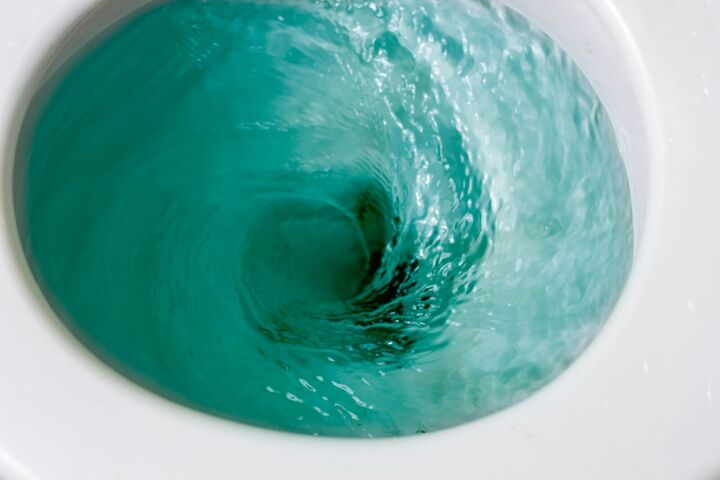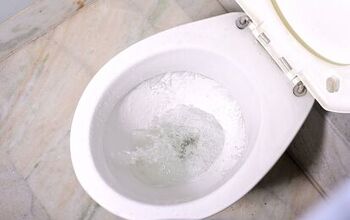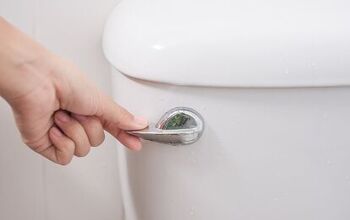Toilet Splashes When Flushed? (Possible Causes & Fixes)

If you have a toilet that splashes a little too much, whether it’s a couple of droplets or a volcano, you know how irritating this problem can be. No one wants to sit on or have to constantly clean up after a toilet that keeps splashing when flushed. Unfortunately, this issue can happen in even the cleanest of households – resulting in water marks on the toilet seats and walls, and irritated guests.
In most cases, when you have water shooting out of the toilet bowl after a flush, this is usually caused by the amount of water that runs into the bowl. Though, there are a number of factors that can cause toilet backsplash. Whether it’s the result of a faulty toilet flapper, clog, or blocked rim jets, or faulty fill valve, this is one issue you’ll want to address right away.
We’ve put together a couple of ways that you can diagnose and fix this problem to have your toilet flushing again without any unwanted liquid getting all of your bathroom.
Do You Need to Install or Repair a Toilet?
Get free, zero-commitment quotes from pro contractors near you.

Water Level Too High
If the water level in the toilet bowl is too high, water can fly out and land on rugs, walls, and toilet users. High water in the bowl is typically caused by some issue with the flapper – whether it’s worn or misaligned – or waste blockage. In some instances, though, a proper flush (without splashing) can be achieved by simply adjusting the toilet fill valve.
1. Servicing the Toilet Flapper
First, you want to locate the toilet flapper which can be found is found inside of the tank. The toilet flapper is a round, rubber disc that is attached to the bottom of the overflow tube. It typically has mounting arms that attach to ears on either side of the tube. The purpose of the toilet flapper is to create a seal, closing off the flush valve to keep water in the tank. When the handle is pressed to flush the toilet, the flapper opens up the valve to deliver water to the bowl.
Put simply, your toilet flapper controls the volume of water that gets released to the bowl. As such, they are often the leading cause of running toilets, leaking, and too much water in the bowl. If suspect that your flapper is the culprit for why your toilet is splashing when flushed, here’s what you can do to ensure that the water level returns to normal:
- Align the flapper. The flapper should be properly aligned to ensure that the seal prevents the flush valve from opening. Small adjustments to the flapper may be enough to stop too much water from getting into the bowl.
- Fix a pinched lift chain. The lift chain, attached to the flapper, should not be too long so that it pinches between the flush valve and the flapper itself. If the chain is too long, too much water will get into the toilet bowl after each flush. To fix this, shorten the chain slightly so that it doesn’t get trapped underneath the flapper.
- Replace the flapper. If you notice that the rubber of the flapper is worn, old, or cracked, it won’t be able to provide a proper seal to stop water from flowing. Also, pay close attention to how the flapper acts during a flush. It should stay up until all of the water is out of the tank. If it drops quickly, you’ll want to install a new flapper.
Oftentimes, when the toilet flapper needs servicing, replacement is the best course of action. They are easy to remove and new flappers are very inexpensive.
2. Clearing Toilet Blockages
Obviously, a clog in the waste line can cause the water level in the bowl to rise. If the blockage in the line is severe enough, the toilet may overflow or splash when you try to flush. More often than not, forceful plunging is enough to loosen clogs to be flushed away.
However, it’s not uncommon for a disposable diaper or feminine product to get lodged into the waste line. In this case, you can clear out the blockage using a snake or toilet auger. Simply feed the snake down the drain and crank it when it cannot go any further.
3. Adjusting Toilet Fill Valve
Your toilet fill valve, also known as a ball cock, is responsible for controlling the water flow that refills the tank after a flush. There are several different types of fill valves, each with their own method for adjusting the water level.
- For toilets with a diaphragm style ball cock, you can try lowering the water level by lowering the float arm.
- For toilets with a floatless ball cock, turn the adjustment screw on the top counterclockwise to lower the water level.
- For toilets with a floating-cup ball cock, the water level can be lowered by pinching the spring clip and sliding the float cup down.
- For toilets with an older plunger-valve style ball clock, consider replacing it with a diaphragm to correct the issue, and update your toilet’s valve system.
Blocked Rim Jets
Most homeowners are unaware of the fact that the water jet openings on the underside of a toilet bowl’s rim can become dirty and blocked with mineral deposits and bacteria. Not only does bacteria present a health concern, the buildup of gunk and mineral deposits can block the flow of water – leading to water spraying out of the bowl. These rim jets are the openings that water flows from the tank into the bowl to begin a flush cycle.
The jets are angled in such a way that creates a circular motion and a more efficient flushing action. When your toilet’s rim jets are clogged, you may notice that your toilet doesn’t flush completely, it takes a long time for the water to fill in the bowl, or the toilet splashes when flushed. You can inspect the jets by using a mirror to find dark orange or black spots indicating bacteria or mineral deposits that appear scaly and light in color.
To clean the bacteria collecting in the jets, you’ll want to make a solution of one part bleach to 10 parts water. Remove the toilet’s tank lid and pour the solution into the overflow tube. Wait for about five minutes for the bleach solution to do its thing, then flush the toilet. Use a piece of wire and mirror to scrape around each jet hole to remove all of the gunk. Finally, scrub around the jets with a specialized toilet bowl cleaner and flush a bleach solution through one last time.
To clear out the mineral deposits, heat up about 8 to 12 ounces of vinegar so that it is warm to the touch. Pour this liquid into the overflow tube, let it sit for about 30 minutes, and then flush. Next, clean the rim jets one at a time using an Allen wrench and a mirror. Use caution when the wrench, as porcelain can chip easily.
Faulty Fill Valve
Last, but certainly not least, the cause of your toilet splashing when flushed may be a faulty fill valve. If you’ve already tried adjusting it to no avail, the whole thing may need to be replaced. Aside from the splashing, some other signs that your fill valve needs replacing include:
- Humming or screeching. As the metal components of a fill valve wear out, the valve may not open or close smoothly, resulting in some disturbing sounds. A low, humming noise is usually the first indication that water isn’t flowing freely. Once this sound turns to an irritating screeching, it typically means that the metal parts are loose and the valve is going to fail soon.
- Running toilet. If the fill valve is worn out, the toilet will run. A faulty valve is a common cause for water in the tank being too high. Also, the water in the bowl is going to be too high since it’s constantly running, which can lead to splashing.
Do You Need to Install or Repair a Toilet?
Get free, zero-commitment quotes from pro contractors near you.

Related Questions
Should you flush with the toilet lid closed?
Yes, you should close the toilet lid before you flush – especially if your toilet is splashing. Since the water in the bowl contains bacteria and other microbes from the urine, waste, and even vomit, some of the droplets produced when flushing could release these nasty microbes into the room. In some cases, your flush may produce potentially infectious aerosols that can survive on surfaces for weeks to months. So, always close your toilet lid before flushing.
Is it bad if toilet water splashes on you?
If, for whatever reason, you accidentally got toilet water on you, you’re not alone. Fortunately, toilet water that sits in the bowl is freshwater but if the water contains urine or feces, there may be a slight cause for concern. Of course, toilet bowls are thriving with bacteria, but 99% of the time, you are going to be perfectly find if a bit of toilet water splashes on you.
How dirty is flushed toilet water?
A toilet bowl contains an average of 3.2 million bacteria per square inch.

Jessica considers herself a home improvement and design enthusiast. She grew up surrounded by constant home improvement projects and owes most of what she knows to helping her dad renovate her childhood home. Being a Los Angeles resident, Jessica spends a lot of her time looking for her next DIY project and sharing her love for home design.
More by Jessica Stone



























